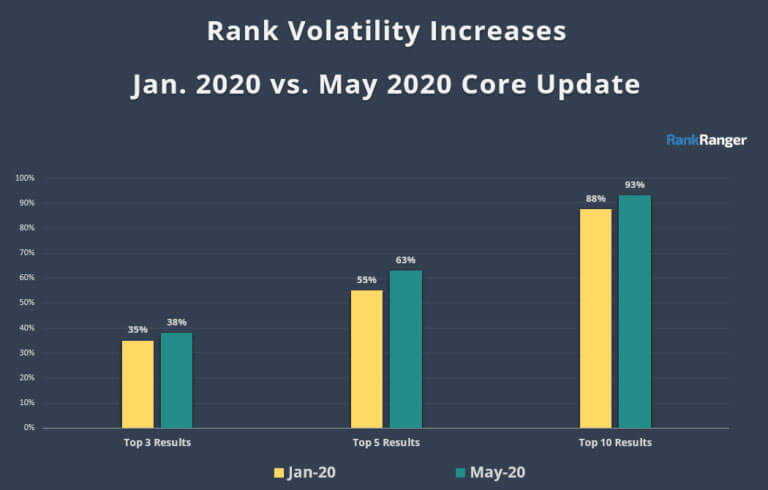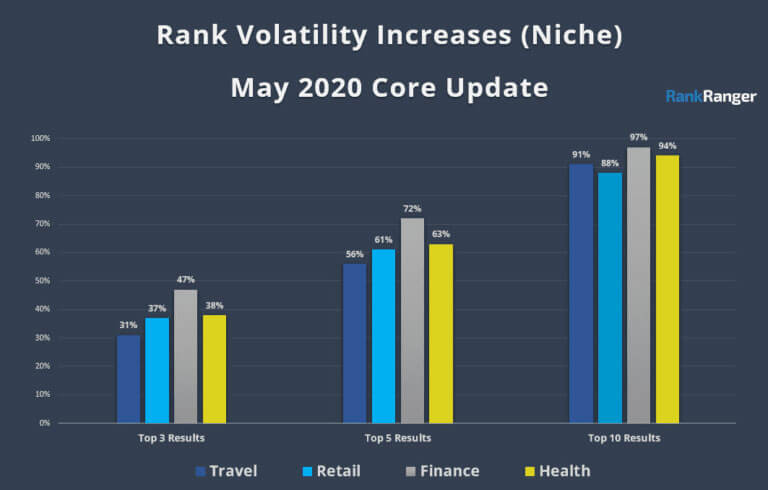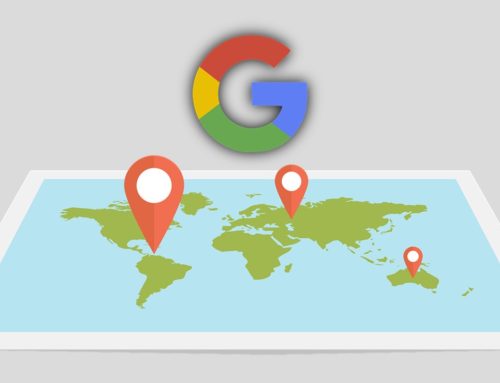On May 4. 2020, Google rolled out a major update to its search algorithm. Google call it a “core” update because it’s a large change to their search engine algorithm, which means it impacts a lot of websites position in organic search.
To give you an idea of how big this core update is, just look at the graph below by SEMrush Sensor. This chart tracks Google results on a daily basis. When it shows things in green or blue for the day, it means there isn’t much movement. But when it turns red, it means there is volatility in the rankings.
We recommend you to log into your Google Analytics account and check the changes in your website organic traffic. Hopefully, it has gone up. If it hasn’t, don’t panic. We have some information that will help you out.
An Observation: Large SERP Volatility
Our observation is that this core Google algorithm update produced higher SERP volatility than any other core update. According to RankRanger, the impact of this update is greater than the one in January.

It is also worth mentioning how this update is affecting multiple niches across the board.

The average volatility in both travel and retail, for example, increased from 1.9 at the end of April to 6.1 on June 10.
Google’s May 2020 Core Update: Winners & Losers
News websites gained the most positions in May, followed by Business & Industrial and Online Communities. Whereas the local businesses and some famous websites were hit hard. Some famous websites which got hurt by this update are:
- Spotify.com
- Creditkarma.com
- LinkedIn.com
- Legoland.com
- Nypost.com
One big misconception is that if you have a high DA or domain score, you’ll continually get more traffic and won’t be affected by such core updates. That is false.
What Should You Do If You Were Hit
It’s important to note that, according to Google, Core update is not designed to penalize anyone, and there may not be a lot to do to “fix it.”
“There’s nothing wrong with pages that may perform less well in a core update. They haven’t violated our webmaster guidelines nor been subjected to a manual or algorithmic action, as can happen to pages that do violate those guidelines.
In fact, there’s nothing in a core update that targets specific pages or sites. Instead, the changes are about improving how our systems assess content overall. These changes may cause some pages that were previously under-rewarded to do better.”
Nothing to fix? What does this mean?
Getting less traffic isn’t necessarily a bad thing. For instance, you may have been ranking and getting traffic for search phrases that didn’t match the intent of the user and purpose of your website. You’d be getting the traffic, but visitors would bounce off your site. This update is all about getting the right traffic, not the most traffic.
Advice for the Core Update?
Since, Google is notoriously non-descriptive about Google’s May 2020 Core Update. Google support team is directing all Twitter questions back to an August 2019 blog post, “What webmasters should know about Google’s core updates.”
Google continues to stress the importance of having the best content possible on your website. Quality is the most important measure. You should audit your website’s content and brush up on Google’s E-A-T standards (Expertise, Authoritativeness, and Trustworthiness).
Some Friendly Tips:
Update your content frequently: We are not suggesting to create new content daily or even weekly. Re-shuffle and update your existing content not just by adjusting a sentence or adding an image. But by adding a handful of new paragraphs, deleting irrelevant information, and sometimes even re-writing entire articles. This will help improve the rank by sending positive signals to google that your content is relevant and upto date. Websites that keep content fresh see around 10% jump in their ranks and traffic.
Fix your thin content: Websites with thin content have 3x more likelihood of being affected in a negative way than a positive one. Although, it is worth mentioning that the majority of the websites with thin content saw little to no change at all, but still, a whopping 31.75% saw a decrease.
Fix your website SEO errors: Find and fix your sites on-page SEO errors. Make sure you have not overstuffed your content with keywords, have proper content structure, images and videos are optimized. More importantly, you should fix and avoid having duplicate meta description and title tags. This can improve you traffic by around 10%.
Conclusion:
Even if you do everything we discussed above, there is no guarantee how you’ll be impacted by Google core algorithm update. Each update is different, and Google’s goal is to create the best experience for searchers. The winners of one update become the losers of the next and vice versa. Creating a better user experience for your site visitors should always be your goal.
With this core update it’s clear that SEO is about providing a better experience than your competition. If this is your core focus too, you’ll find that you’ll do better than your competition, in long run.
Worried About Google’s Update? The WeCT Is Here to Help!
Google’s May 2020 Core Update might be hash for businesses already struggling to pay the bills. But, following Google’s E-A-T content guidelines is a good start for holding onto your positions.
If your search ranking and organic traffic has dropped substantially, you will need to shift your site content and SEO strategies to stay competitive. That’s where we can help!
WeCT digital marketing experts can work with you to craft a new game plan to get back on top.
Recommended for you
Re-imagining businesses through experiences
We are a full-service digital agency with leading capabilities across digital – from web design to development, branding to marketing, cloud transformation to security. We create human-centered and future proof experiences – enabling transformation, ensuring sustainable growth.


